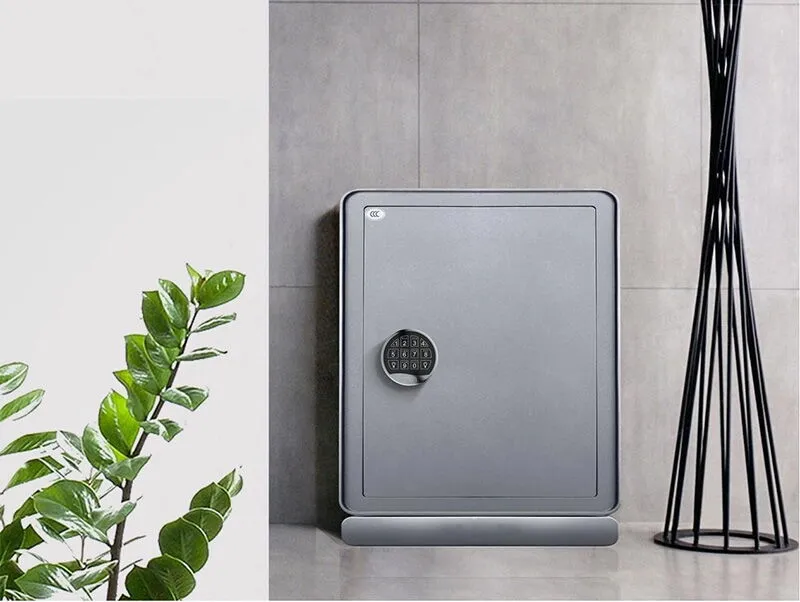On this page
When choosing the right safe lock for your security needs, it's important to understand the distinct features of the main types of safe locks available. Safe locks can often be interchanged due to standardized mounting dimensions, allowing you to select from mechanical combination locks, digital locks, or key locks based on your preference.
Despite this interchangeability, the intrinsic characteristics of each lock type vary, making some more suitable for specific situations. For instance, a mechanical lock is more reliable in harsh environments like damp outdoor conditions compared to an electronic lock. Let's explore the most common types of safe locks currently in use.

Key-operated safe locks are a reliable choice for those who struggle with remembering combinations. They are known for their durable construction and provide sufficient security, as long as the key is kept secure and separate from other keys. However, one drawback is their susceptibility to theft, as the key can be targeted by thieves aware of the presence of valuables.
Key locks offer simplicity and affordability, making them popular. However, managing the key is crucial for security. Leaving the key near the safe can compromise its safety. Despite their simplicity, key-operated locks require careful consideration of key storage to prevent unauthorized access.
Electronic combination safe locks come in various designs, featuring a keypad for code entry and an internal mechanism for storing codes and activating locking bolts. This category also includes biometric options like fingerprint scanners.
Mechanical combination safe locks, also known as dial or wheel combination locks, are iconic in the safe industry. They use a dial to input codes, with internal wheel packs setting the combination.
Biometric fingerprint safes are advanced security solutions offering top-tier protection for homes and businesses. They utilize cutting-edge technology to safeguard your valuables.
How Biometric Fingerprint Safes Work: A biometric fingerprint safe operates by scanning and identifying your unique fingerprint, which is stored in a secure database within the safe. When your fingerprint matches the stored data, the safe unlocks, providing access restricted to your biological imprint.
Selecting the ideal safe lock depends on your personal preferences and needs. Consider whether you prioritize remembering codes or carrying keys. Each lock type offers unique advantages and disadvantages, so it's essential to weigh these factors carefully before making a decision. For more information or assistance, feel free to reach out to us.
Despite this interchangeability, the intrinsic characteristics of each lock type vary, making some more suitable for specific situations. For instance, a mechanical lock is more reliable in harsh environments like damp outdoor conditions compared to an electronic lock. Let's explore the most common types of safe locks currently in use.

Key-operated Safe Locks
Key-operated safe locks are a reliable choice for those who struggle with remembering combinations. They are known for their durable construction and provide sufficient security, as long as the key is kept secure and separate from other keys. However, one drawback is their susceptibility to theft, as the key can be targeted by thieves aware of the presence of valuables.
Key locks offer simplicity and affordability, making them popular. However, managing the key is crucial for security. Leaving the key near the safe can compromise its safety. Despite their simplicity, key-operated locks require careful consideration of key storage to prevent unauthorized access.
Features of Key-operated Safe Locks
- Simple and cost-effective.
- Allows multiple users with individual keys, but lacks auditability.
- Key remains in the lock and cannot be removed unless the safe is closed.
- Risk of key loss.
Benefits of Key-operated Safe Locks
- Affordable to purchase.
- Easy to operate.
- Option for duplicate keys in case of loss, ensuring access to the safe.
Drawbacks of Key-operated Safe Locks
- Risk of key loss.
- Potential vulnerability if keys are not securely stored.
Electronic Combination Safe Locks
Electronic combination safe locks come in various designs, featuring a keypad for code entry and an internal mechanism for storing codes and activating locking bolts. This category also includes biometric options like fingerprint scanners.
Features of Electronic Combination Safe Locks
- Eliminates the risk of key loss or theft.
- Requires a power source, typically batteries.
- Allows individual users to set and change their codes, enabling audit trails to track safe access.
- Some models require manual locking after code entry via a keypad, knob, or handle.
Benefits of Electronic Combination Safe Locks
- Highly reliable and secure.
- Suitable for multiple users, including an administrator with a master code.
- Includes features like lockout after incorrect attempts.
- Offers options like opening delay, dual codes, alarm integration, and time lock functions.
- Administrators can create, modify, and delete access codes.
Drawbacks of Electronic Combination Safe Locks
- Prone to occasional operational errors.
Mechanical Combination Safe Locks
Mechanical combination safe locks, also known as dial or wheel combination locks, are iconic in the safe industry. They use a dial to input codes, with internal wheel packs setting the combination.
Features of Mechanical Combination Safe Locks
- Eliminates the risk of key loss or theft.
- Codes can be changed if compromised.
- Only one code is available, necessitating sharing for multiple users.
- No audit trail to identify who accessed the safe.
- Requires dial manipulation to lock.
Benefits of Mechanical Combination Safe Locks
- High level of security.
- Ability to change codes easily if security is compromised.
- Simple operation involving dial manipulation.
Drawbacks of Mechanical Combination Safe Locks
- Higher initial cost compared to some other types of locks.
Biometric Fingerprint Safe Locks
Biometric fingerprint safes are advanced security solutions offering top-tier protection for homes and businesses. They utilize cutting-edge technology to safeguard your valuables.
How Biometric Fingerprint Safes Work: A biometric fingerprint safe operates by scanning and identifying your unique fingerprint, which is stored in a secure database within the safe. When your fingerprint matches the stored data, the safe unlocks, providing access restricted to your biological imprint.
Features of Biometric Safe Locks
- Utilizes fingerprint recognition.
- Includes anti-manipulation locks.
- Offers high-security standards.
Benefits of Using Biometric Safe Locks
- Eliminates the need to remember combinations or keys; access is granted with a simple touch of your finger.
- Provides state-of-the-art security, ideal for specialized needs like protecting firearms in a biometric gun safe.
- Some models may include backup keys or codes for added security.
- Suitable for multiple users, including an administrator with a master code.
- Includes anti-manipulation locks that activate after incorrect fingerprint attempts.
- Eliminates the risk of multiple keys.
Drawbacks of Using Biometric Safe Locks
- Higher initial cost compared to other types of safe locks.
- Reliability can be affected by factors like fingerprint quality and sensor calibration.
Conclusion
Selecting the ideal safe lock depends on your personal preferences and needs. Consider whether you prioritize remembering codes or carrying keys. Each lock type offers unique advantages and disadvantages, so it's essential to weigh these factors carefully before making a decision. For more information or assistance, feel free to reach out to us.

 Español
Español 中文
中文
